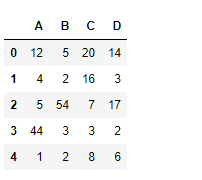Python | Pandas dataframe.max()
Last Updated :
19 Nov, 2018
Python is a great language for doing data analysis, primarily because of the fantastic ecosystem of data-centric python packages. Pandas is one of those packages and makes importing and analyzing data much easier.
Pandas dataframe.max() function returns the maximum of the values in the given object. If the input is a series, the method will return a scalar which will be the maximum of the values in the series. If the input is a dataframe, then the method will return a series with maximum of values over the specified axis in the dataframe. By default the axis is the index axis.
Syntax: DataFrame.max(axis=None, skipna=None, level=None, numeric_only=None, **kwargs)
Parameters :
axis : {index (0), columns (1)}
skipna : Exclude NA/null values when computing the result
level : If the axis is a MultiIndex (hierarchical), count along a particular level, collapsing into a Series
numeric_only : Include only float, int, boolean columns. If None, will attempt to use everything, then use only numeric data. Not implemented for Series.
Returns : max : Series or DataFrame (if level specified)
Example #1: Use max() function to find the maximum value over the index axis.
import pandas as pd
df = pd.DataFrame({"A":[12, 4, 5, 44, 1],
"B":[5, 2, 54, 3, 2],
"C":[20, 16, 7, 3, 8],
"D":[14, 3, 17, 2, 6]})
df
|

Let’s use the dataframe.max() function to find the maximum value over the index axis
Output :

Example #2: Use max() function on a dataframe which has Na values. Also find the maximum over the column axis.
import pandas as pd
df = pd.DataFrame({"A":[12, 4, 5, None, 1],
"B":[7, 2, 54, 3, None],
"C":[20, 16, 11, 3, 8],
"D":[14, 3, None, 2, 6]})
df.max(axis = 1, skipna = True)
|
Output :

Share your thoughts in the comments
Please Login to comment...